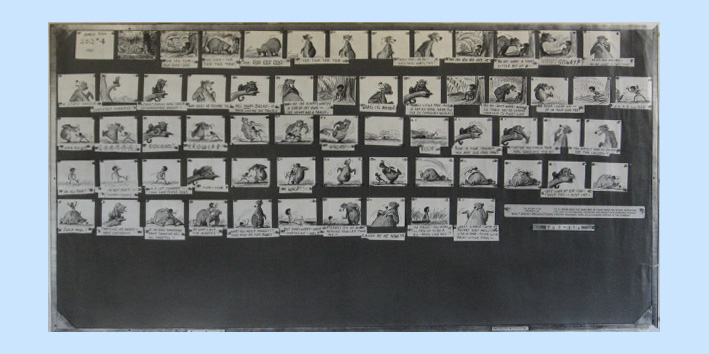Bill Peet describes his passion for drawing in his autobiography. In 1933, he was awarded a scholarship to John Herron Art School in Indianapolis, Indiana, in the depths of the Great Depression. Bill could draw anything and excelled in every medium he tried. His instructors kept his sculptures. But Bill Peet wanted to be a painter. Although he won many prizes for his paintings, he knew that hard economic times would not allow him to pursue his dream.
In 1937, when Walt Disney Studios advertised positions for artists, he saw a chance to draw for a living. He began as a low-level animator called an inbetweener. Except for backgrounds and still figures, each frame of an animated film requires a drawing of the characters in a slightly different pose, so when seen in rapid sequence they appear to move. These pencil drawings were then copied in black ink on to transparent cells, and the spaces between the lines filled with paint by the "girls" of Ink and Paint.
It was mind numbing work. Inbetweeners worked on light boards; drawing tables with circular, rotating glass tops which were illuminated from behind. "The window shades were drawn to darken the rooms to make the light boards more effective. This was one of the reasons the Annex was called 'the black hole of Calcutta' ". The "drawing" consisted of copying the animator's drawings over and over again, with only slight modifications to each drawing. Staring into a bright light for eight hours a day gave Bill Peet headaches. It was not artistic or creative work. "We were just so many drawing robots".
A few inbetweeners graduated to become higher level animators. Bill Peet was lucky. Based on drawings he submitted for an upcoming film, he was assigned to the story department as a sketch artist. Finally he was doing his own drawings, not just copying. At that time the storymen were primarily writers. They needed someone, the sketch artist, to draw their ideas for them and often design the characters. Animation is a visual medium and the writers ideas sometimes did not work visually, so often they relied on the sketch artists to come up with solutions to their story problems. Bill Peet now became involved in the writing the story.
Early animated features had seven or eight people working on the story with character design done by different people, which often resulted in an inconsistent product.
Bill Peet made hundreds of drawings for each film. Because of his facility as a draftsman, he never tried to "fix"a drawing if it was not what he wanted. He would wad it up and throw it towards the trash can. He often missed and the floor of his room, 3B8 in the animation building, was littered with paper. Some of his drawings were more finished and done in color to show the animators how to draw the character. Now it was the animators who were copying his drawings.

According to John Canemaker in his book "Paper Dreams", Ward Kimball believed Walt was envious of Bill's drawing ability. Ward said "Look at Bill's sketches, as rough as some of them are, they're perfect! The pose and everything else.".

In an interview with John Canemaker, animator Ollie Johnston said "Bill's drawings were so great, they stimulated the animator"
The late Joe Ranft was quoted by Charles Solomon in an L. A. Times obituary. "His (Bill Peet's) pastel drawings were so alive, they just knocked me over. Even though they were still drawings, they screamed to be animated."
Having an intimate knowledge of animation, Bill Peet was able to show animators how to transition from one storyboard drawing to the next. Eventually he also directed the actors who gave voice to the characters. On the previous page are some comments on Bill Peet's work by two of the nine old men, animators Frank Thomas and Ollie Johnston.
Looking through the archives of the Disney Animation Research Library, one can usually spot Bill Peet's drawings. His are fresh and loose, but expressive, and not labored and tight. His drawings never include corrections or preliminary guide lines, often seen in the sketches of those less skilled. In recognition of Bill Peet's contribution on 101 Dalmatians, his story credit was animated as if he was signing his name; an unprecedented and unique tribute.

